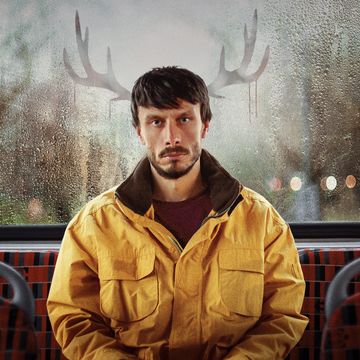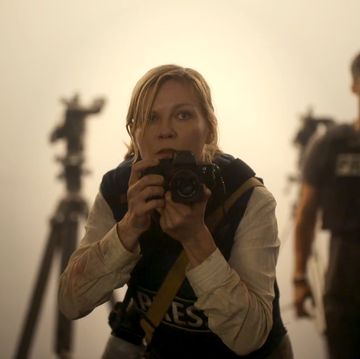True crime stories tend to fall broadly into one of two camps: the Miscarriage Of Justice, or the Unsolved Mystery. In the first category is Serial, the groundbreaking 2014 podcast that reinvigorated the true crime genre (which ushered in HBO's The Jinx, Netflix's Making a Murderer, and ESPN's OJ: Made in America). The second category has been dominated this year by the still-mysterious murder of child pageant star JonBenét Ramsey, which inspired five separate TV projects last month.
In the Dark, a new investigative podcast from American Public Media, falls into neither category. Focusing on the disappearance of 11-year-old Jacob Wetterling, who was abducted from his Minnesota hometown 27 years ago, the show is a worthy spiritual successor to Serial but without the inevitably anticlimactic ending. Because on 6 September of this year—just a week before In the Dark was originally due to launch—Wetterling's killer Danny Heinrich confessed to police, bringing an almost three-decade investigation to a close.
But that real-life plot twist didn't change the show as much as you'd expect. As of today, six episodes of In the Dark have been released, so here's what you need to know before you catch up.
Like Serial, this is high-quality investigative journalism in audio form.
The podcast and its investigation is led by Peabody-winning reporter Madeleine Baran, whose calm, articulate narration anchors the listener as much as Sarah Keonig's did in Serial. Her clear-eyed sincerity and methodical reporting are your guiding light through an almost unbearably grim story.
Jacob Wetterling was taken at gunpoint by a masked man on 22 October 1989, in front of his younger brother Trevor and his friend Aaron Larson. The trio were biking home from a local video store in St. Joseph, Minnesota when the man emerged from a driveway, ordering them to throw away their bikes and lie down on the ground. He then told Trevor and Aaron to run away, or they would be shot. Jacob was never seen again, and for 27 years these were all the details that were known about his disappearance.
In his confession last month, Heinrich told police that he had seen the boys cycling into town, and waited for them to return. After Trevor and Aaron had gone, he drove Jacob to a secluded nearby gravel pit and sexually assaulted him, then shot him dead after a passing patrol car made him panic. After going home for a couple of hours, Heinrich returned to the scene and buried Jacob's body nearby.
Unlike Serial, this is not a "whodunit."
The question at the core of In the Dark is not "What happened?" but "How did this happen?"–and the "this" in that sentence is not the crime, but the failed investigation. Police were alerted as soon as Trevor and Aaron returned home on the night of 22 October, and thus began what appeared to be an exhaustive, full-scale investigation with officers combing every inch of the surrounding land.
On the surface of it, there is no reason for this case to have gone unsolved for so long. As Baran notes early on: "Jacob was kidnapped on a dead-end road, in a town of just 3,000 people. There were witnesses. Law enforcement got there right away. It seemed like the kind of case that could have been solved that night, while there was still a chance to find Jacob alive."
Heinrich himself was even interviewed by police early on in the investigation, but denied any involvement and was released without charge. Combining old evidence and archive recordings with contemporary witness interviews, Baran tries to unpick what went so deeply wrong with this investigation, and how Jacob's killer remained at large for almost 30 years.
Jacob's kidnapping was not an isolated incident.
Nine months prior to Jacob's disappearance in St. Joseph, 12-year-old Jared Scheierl was kidnapped and assaulted in nearby Cold Spring, by a man who turned out to be Danny Heinrich. There was also a series of sexual assaults in the nearby city of Paynesville between 1986 and 1987, but no arrests were made.
In the Dark's third episode centers on an in-depth, breathtaking interview with Scheierl, who has spent much of his adult life publicly searching for answers in both his own case and Jacob's. The pattern of similar unsolved attacks on children throughout Minnesota is one of the most haunting aspects of the story, and the podcast explores in depth its impact on the local community. DNA evidence from Scheierl ended up leading directly to Heinrich's arrest and confession.
It's often a very, very tough listen.
In the Dark is not lightweight listening for your morning commute. Though Heinrich's confession brings an unexpected sense of closure to the story, it also brings a overwhelming sense of doom. Jacob's parents, Patty and Jerry Wetterling, are interviewed by Baran throughout the podcast, and their contributions are about as wrenching as you'd expect.
In the weeks following Jacob's disappearance, police gave Patty and Jerry a dedicated phone line on which members of the public could phone in tips. Episode Four features archive recordings of these calls, many of which were from "psychics" claiming to know, often in graphic detail, what had happened to Jacob. Patty and Jerry's admirable patience with these calls, and their desperation for any scrap of information about their son, is hard to hear.
Similarly galling is the fate of Dan Rassier, a local music teacher who was wrongfully suspected of being involved with Jacob's disappearance. His life was effectively ruined for years after law enforcement publicly identified him as a person of interest, and his stuff-of-nightmares story is the focus of In the Dark's fifth episode.
The title In the Dark makes literal reference to the night on which Jacob was taken. But it gestures more damningly at the obfuscation that surrounded the investigation, and the lack of understanding which led to so many errors and missed opportunities—as Baran says, "an investigation that happened in the dark."














